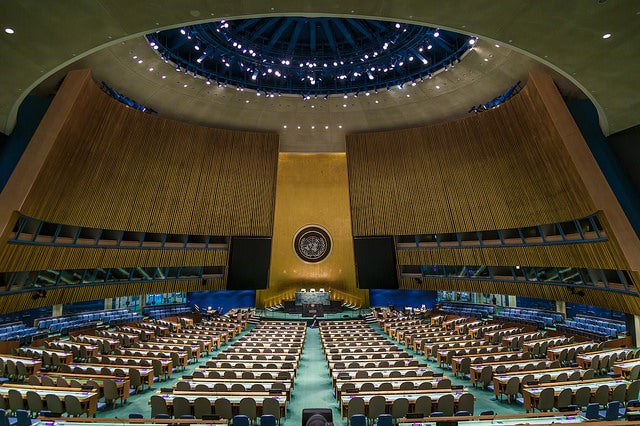Just hours ago, the United Nations’ General Assembly, or UNGA, officially adopted the Sustainable Development Goals: goals that will hopefully unite the world for the next 15 years to end extreme poverty and improve the livelihoods and health of all.
 These 17 goals bridge a wide array of topics—from climate change to nutrition, inequities to health—with the hope of sustainably improving the lives of billions around the world. Of these goals, nine explicitly mention women (SDGs 1, 2, 3, 4, 5, 6, 8, 11, 13). Importantly, an entire goal, SDG 5, is dedicated to the achievement of gender equality and empowerment of all women and girls. However, to the disappointment of many, only one goal is specific to health: SDG 3, to ensure healthy lives and promote well-being for all at all ages. Important to the maternal and newborn health community, under this goal, target 3.1 is to reduce the global maternal mortality ratio to less than 70 per 100,000 live births by 2030.
These 17 goals bridge a wide array of topics—from climate change to nutrition, inequities to health—with the hope of sustainably improving the lives of billions around the world. Of these goals, nine explicitly mention women (SDGs 1, 2, 3, 4, 5, 6, 8, 11, 13). Importantly, an entire goal, SDG 5, is dedicated to the achievement of gender equality and empowerment of all women and girls. However, to the disappointment of many, only one goal is specific to health: SDG 3, to ensure healthy lives and promote well-being for all at all ages. Important to the maternal and newborn health community, under this goal, target 3.1 is to reduce the global maternal mortality ratio to less than 70 per 100,000 live births by 2030.
Now that the UN’s 193 member states have agreed to achieve these goals, turning words into action is critical. Of this, UN Secretary General, Ban Ki-moon said this afternoon:
We need action from everyone, everywhere. Seventeen sustainable development goals are our guide… The 2030 agenda compels us to look beyond national boundaries and short-term interests and act in solidarity for the long-term… We can no longer afford to think and work in silos. Institutions will have to become fit for purpose, a grand new purpose. (The Guardian)
An important part of these goals is tomorrow’s launch of the new global strategy for women’s, children’s and adolescent health, part of the Every Woman Every Child movement, originally launched by Ki-moon in 2010.
The new global strategy for women’s, children’s and adolescents’ health puts people at the center of the sustainable development goals (SDGs) and aims to mobilize everyone, governments, businesses, academia, civil society, in ensuring their success. Only by putting women, children and adolescents at their heart can the SDGs bring about the transformation needed to attain and sustain the future we want, where women, children and adolescents everywhere have the opportunity to live healthy and prosperous lives.
– Dr. Flavia Bustreo, Assistant Director-General of Family, Women’s and Children’s Health at the World Health Organization, today. (The Guardian)
The Global Maternal Newborn Health Conference in Mexico City, Mexico next month will bring technical experts together to strategize on how to meet these commitments, with a focus on quality care, integration and equity.
To learn more about what the SDGs and new global strategy mean for women’s health, check out these posts:
- The Cost of Delivery, The Price of Survival
- No magic bullet, but no excuses: we know what works for women’s and girls’ health
- A New Era for the Health of Women, Children, and Adolescents
- It’s Not Complicated: Contraceptives Save Lives and Improve Health
- Read live coverage of UNGA and more at Crowd 360 by FHI 360
Photo 1: “Sights of the United Nations Guided Tour” © 2015 John Gillespie, used under a Creative Commons Attribution license: http://creativecommons.org/licenses/by/2.0/
Photo 2: “Japan Earthquake Commemoration Concert, United Nations, NY” © 2012 John Gillespie, used under a Creative Commons Attribution license: http://creativecommons.org/licenses/by/2.0/
Photo 3: Ethiopian Woman with her newborn. © 2014 Katie Millar/MHTF
